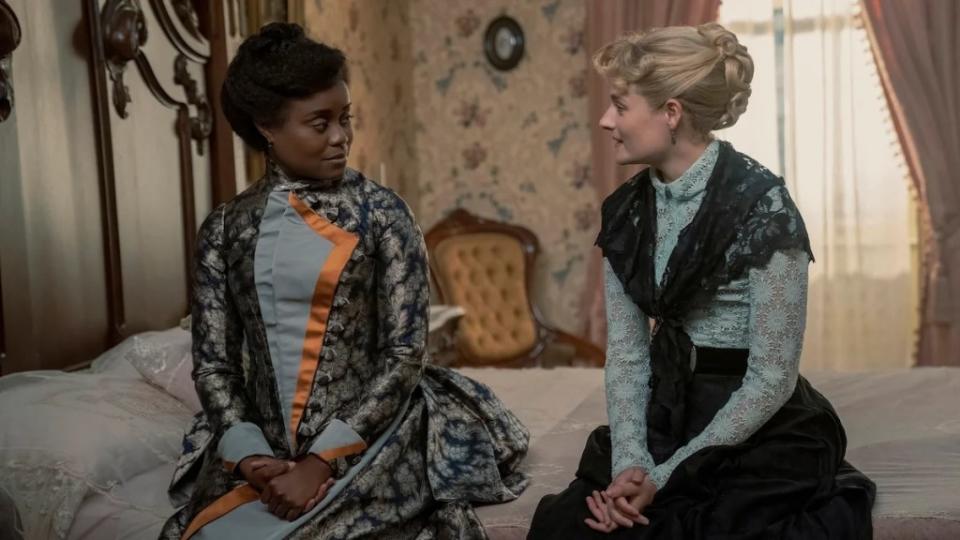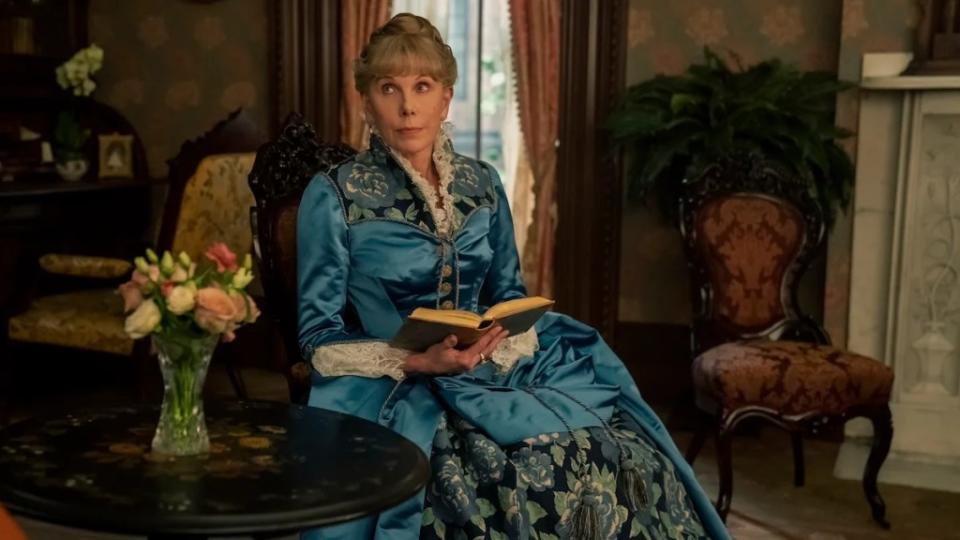‘The Gilded Age’ Season 2 Review: HBO Drama Boasts Flashy Sets, Falters on Story
There’s ample gold leaf in Season 2 of Julian Fellowes’ “The Gilded Age,” miles of flashy yardage, a flock of feathered hats and swoon-worthy Fifth Avenue ballrooms. For many viewers, this visual candy will be more than enough to soothe the hunger left in the wake of the creator’s massive British hit “Downton Abbey.”
The design porn bounty continues in this HBO period drama that zeroes in on the villas of East 61st Street, setting the scene for conflicts between industrial progress and the horse-drawn carriage, capital and labor, upstairs and downstairs, old money and the nouveau riche, Black and white, men and women and, most pungently, women and women.
The battle of the real housewives of East 61st Street begins on Easter 1883. Amid fabulous arrangements of peonies and roses, drawing rooms become battlefields for social power and the breeding of a next generation of the 19th century one percent, a new crop of nepo babies.
Hail to the return of many favorite characters. Batting for team new money is the egregiously ambitious Bertha Russell (Carrie Coon), her robber baron husband (Morgan Spector) and their eligible children Gladys and Larry (Taissa Farmiga, Harry Richardson). In opposition are the powerful old money doyenne Mrs. Astor (Donna Murphy), un-neighborly sisters Agnes Van Rhijn (battle ax Christine Baranski) and submissive Ada Brook (Cynthia Nixon), and their marriageable if headstrong niece Miss Brook (Louisa Jacobson).
Englishman Fellowes hovers over them all, a little more jaded and judgmental than he was on his native soil. Compared to the English aristocracy, they’re all new money.
Nathan Lane steps up as opportunistic social referee Ward McAllister, a sort of 19th century Truman Capote, flitting between camps with a Southern drawl to shame Colonel Sanders. Meanwhile, the damask curtain is pulled back on Black Brooklyn bourgeois society by nascent journalist and Miss Brooks’ confidante, Miss Scott (Denée Benton). The countless servants form another camp, some striving to capitalize on America’s promised freedoms, and others born to fetch and carry.

Story arcs are abundant and we’ll avoid the spoilers that I’m sure savvy audiences will see coming towards them like a runaway train. The Russell marriage is often under siege, and sibling spats are nothing new to the wishy-washy Ada and the opinionated Agnes. Gladys, Miss Brook and Miss Scott are often looking for love in all the wrong places – something their elders are quick to remind them, and that they are equally adept to forget. The same could easily be said for Agnes’s closeted son, Clark (Blake Ritson), whose search for an appropriate match is at complete odds with his desires.
Like the banners strewn from the mansions on holidays, the arcs continue to flutter in the writers’ breeze. The opera wars find Mrs. Russell and Mrs. Astor going head-to-coiffed-head. The dominant figures apply a scorched earth policy maneuvering between dueling opera houses: the established exclusive Academy, and the new Metropolitan that will accept anyone with money. The storyline challenges audiences to invest heavily in a clash the women take with deadly seriousness but is less than compelling.
A rather awkward management versus labor conflict paints Mr. Russell in the David Zaslav, let-them-eat-cake role that plays more dissonantly in the current Hollywood union atmosphere than it might have a year ago. There’s an unexpected wedding, a broken engagement, the rise of the Brooklyn Bridge and the struggles of all the bright-eyed attractive young women, upstairs and down, to find any voice of their own, even a squeak.

What the panoramic show lacks is perhaps the single most essential element of historical fiction: period characters must feel as vital today as they did in their own era. And, here, unfortunately, they don’t. They remain like cardboard cutouts, paper dolls joined from one gloved hand to the next.
Compared to “Downton Abbey,” there’s no one that can touch the hem of Maggie Smith’s Dowager Countess of Grantham. Sure, the matriarch got all the best lines, but despite her stiff upper lip, she made it clear where her character had been broken and repaired. She carried real wisdom in the same handbag as her prejudices. She broke up the tension with snort-inducing laughter. Her willingness to do anything for family ultimately made her a character that had a life of her own, demanding more scenes, more backstory, more narrative arcs as the seasons piled up.
This kind of full character presence that stands the test of time was often evident in “The Crown.” As Queen Elizabeth, Claire Foy’s rise from privileged but sheltered ingenue to wife, mother and royal was oddly relatable — even if we’ll never be crowned. The actress managed to plumb the vulnerabilities of a curious young daddy’s girl, confront the ambiguities of wifehood when married in a love match to a man not her equal in status or character, and the challenge of subverting personal desires in favor of those of a kingdom in wartime.
Jodie Comer caught attention long before “Killing Eve” by juicing up “The White Princess.” The late, great Helen McCrory brought fire to her cigarette smoking, sexy, truth-slinging, gangster matriarch in “Peaky Blinders,” while Cillian Murphy (“Oppenheimer”) could not have been more layered and unpredictable as her nephew Thomas Shelby, the thinking-man’s outlaw on the wrong side of the tracks. In that decade-long series, period details served the characters not the reverse. A bold contemporary soundtrack led by P. J. Harvey’s “Red Right Hand” is as true to the period drama as the music is anachronistic.
With its second season, “The Gilded Age’s” fidelity to historic detail overshadows its broad and wide cast of characters, played by many talented actors often with Broadway roots. That choice makes the show lack the exhilarating alchemy of breathing life into characters built of words and stuffing. They appear both gilded and gelded in an age where so much narrative gold could have been mined.
“The Gilded Age” Season 2 premieres Sunday, Oct. 29, on HBO, and streams on Max.
The post ‘The Gilded Age’ Season 2 Review: HBO Drama Boasts Flashy Sets, Falters on Story appeared first on TheWrap.

